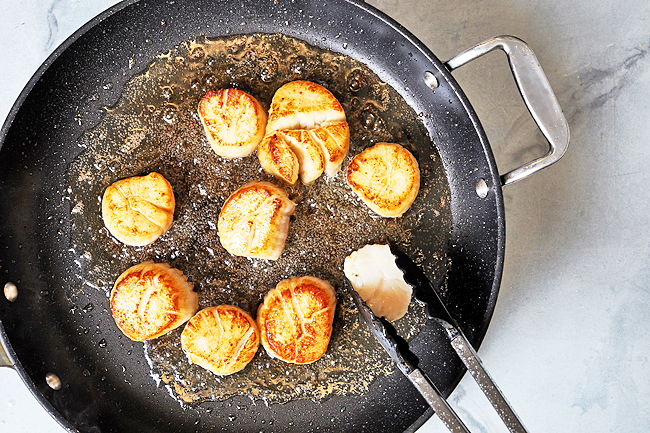Aaron Hutcherson
THE WASHINGTON POST – Browned food is tasty food. Just think about it: Would you prefer a steamed chicken breast or one that has been seared in a skillet? Even if they are seasoned exactly the same, the seared chicken will be more flavourful than the steamed one because how food is cooked impacts flavour, too.
Our senses have two chemical processes to thank for browned, better tasting food: the Maillard reaction and caramelisation. “In Maillard, sugars interact with the amino acids of proteins, creating a cascade of new flavours and aroma compounds, with several hundred possibilities,” staff writer Becky Krystal wrote on the process, which kicks into gear at about 300 degrees.
Caramelisation starts to happen around 340 degrees (it varies depending on the type of sugar) and similarly creates new compounds, but only involves the breakdown of sugar molecules.
These processes can’t take place in moist cooking methods because the liquid will not go above the boiling point of 212 degrees, making Maillard hard to achieve and caramelisation impossible.
Therefore, moisture is the enemy of browning. So for more flavourful dishes, cooks should do all they can to get rid of as much moisture as possible. Here’s what you need to know.

DRY YOUR FOOD
Drying the surface of ingredients is important because doing so means less energy from the cooking equipment is spent evaporating water.
Many of our recipes for meat and seafood in particular include the specific instruction to “pat dry with a towel” for this very reason, but you should dry fruit and vegetables too, especially if you washed them just before cooking.
To go a step further, you can even leave proteins on a wire rack set over a rimmed baking sheet uncovered in the refrigerator (on the bottom shelf) for up to a day to get the surface really dry.
Scallops are a prime example: The key to preparing them well is to not overcook them, and the only way to do that and get a perfect golden crust is to get the surface very dry.
And many scallops are sold in a brine that waterlogs them, making them nearly impossible to brown. That’s why many recipes call for “dry packed” scallops.
If you salt a cut of steak and let it sit on your counter for 20 minutes while you do something else, you’ll notice a layer of moisture on the surface.
KNOW WHEN TO SALT
If you add the steak to the skillet at that moment, that moisture is enough to inhibit it from developing a deep brown crust. So for meat, you want to either salt it just before cooking or at least 45 minutes beforehand to allow the liquid to be reabsorbed (as what happens in dry brining). You can salt in advance for up to one day for small cuts of meat and two days for larger cuts. For fish, Serious Eats culinary editor Sasha Marx lists the recommended refrigerated resting time as: “At least 45 minutes and up to 90 minutes for thick white fish fillets. At least 12 hours and up to 36 hours for Japanese-style salted salmon.”
Ground meat should not be salted in advance. Salting early can also help with watery vegetables, such as summer squash and eggplant. America’s Test Kitchen suggests salting prepped vegetables, putting them in a colander and letting them stands for 30 minutes to four hours before patting dry to get rid of excess moisture. When it comes to mushrooms, you want to wait until they’re almost done cooking before adding salt, which is how you achieve beautifully browned fungi instead of sad grey shrooms.
MAYBE ADD SOME SUGAR
Adding a pinch of sugar, particularly to ingredients that don’t have much of it naturally, is any easy way to get caramelisation.
However, do so judiciously so your savoury dish doesn’t turn into a dessert. And watch it carefully when cooking so it doesn’t burn and become bitter.
GET YOUR SKILLET (OR OVEN OR GRILL) HOT
As I mentioned, a high temperature is key for browning to occur.
When adding ingredients to a skillet, a gentle sizzle lets you know that delicious things are heading your way. If your food is as quiet as a church mouse, take it out and let your pan continue to heat up before proceeding.
Try as you might to remove moisture from the surface of food, there will still be water present that needs to escape during the cooking process if you want it to brown.
GIVE YOUR FOOD SOME SPACE
Whether roasting broccoli on a sheet pan or searing chicken thighs in a skillet, it’s important not crowd the pan.
That way, any moisture released during the cooking process has room to evaporate.
Otherwise, it’ll get trapped in your cooking vessel and the food will steam instead of brown.
MAKE CONTACT – AND CONSIDER APPLYING PRESSURE
While you can get some browning from the hot air in your oven during roasting, most is a result of contact with the pan. So if brown food is what you’re after, it’s better not to use parchment paper when roasting. When cooking ingredients on the stovetop or grill, especially proteins, I sometimes even gently press the food with a utensil (or sometimes my hand) to ensure even contact with the surface of the skillet or grill.







